Catch Mid-Atlantic King Mackerel
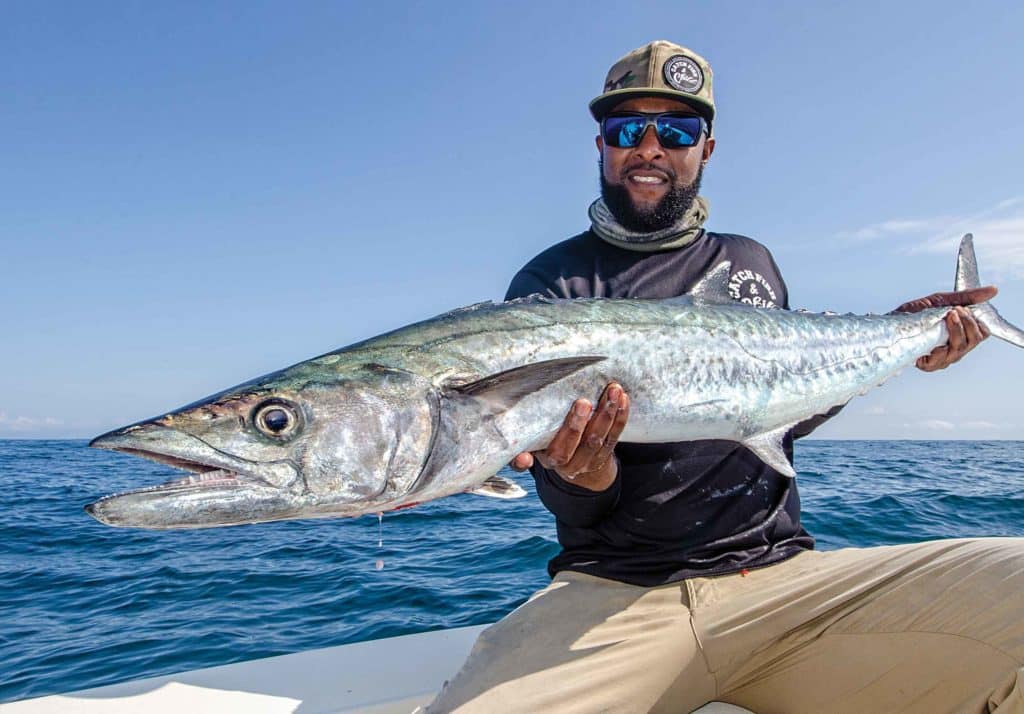 Catching trophy kings like this one doesn’t require long runs offshore in mid-Atlantic waters.
Ric Burnley
Catching trophy kings like this one doesn’t require long runs offshore in mid-Atlantic waters.
Ric Burnley
Things were looking up from the start. I’d loaded the livewell with pork-chop menhaden on the first throw of the cast net, and shortly after I reached the wreck— 15 miles off Virginia Beach—and put out the first livey, a smoker pounded it and was off to the races before I could get a second bait in the water.
I remember hearing that first outrigger clip pop and the line zing off the reel. The rest is sort of a blur. But two hours later, after cranking in and releasing a dozen big kings, I was out of breath, drenched in sweat and nursing sore arms.
King Mackerel Fishing from Maryland to North Carolina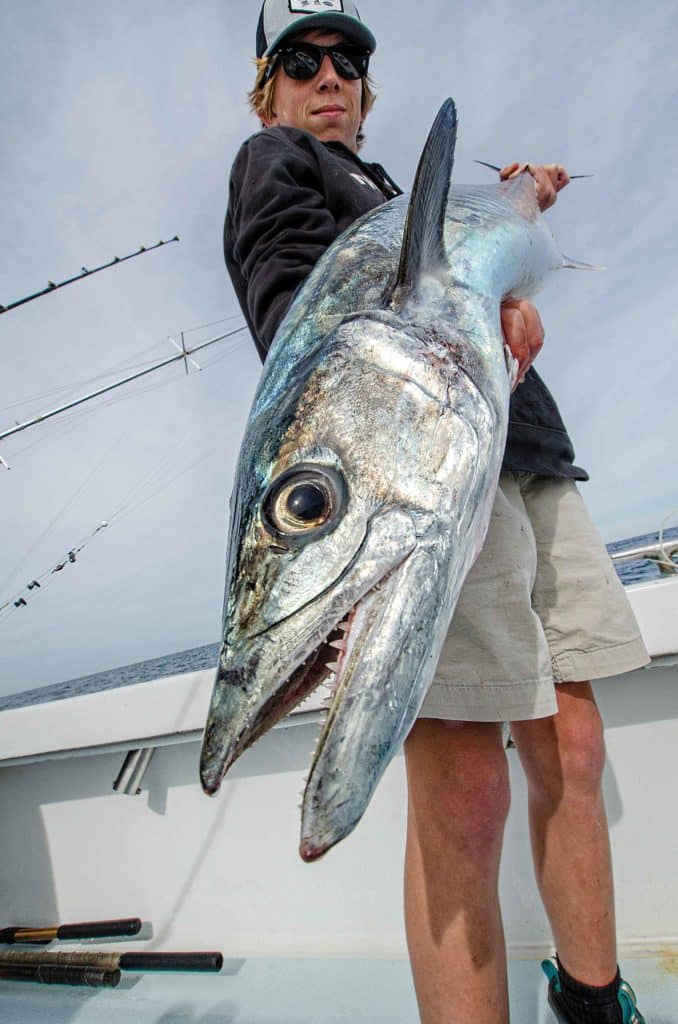 Formidable teeth allow king mackerel to kill or injure prey during high-speed attacks.
Ric Burnley
Formidable teeth allow king mackerel to kill or injure prey during high-speed attacks.
Ric Burnley
Off Virginia Beach, my home port, king mackerel fishing is more of a niche pursuit practiced by a cult of dedicated inshore anglers. Each summer, I will spend hours searching for a king bite. July through September, mid-Atlantic anglers can experience unprecedented action from Maryland to North Carolina’s Outer Banks. Areas where king mackerel were an occasional catch are now becoming hotspots. Warm water, an abundance of bait and local rainfall likely contribute to the world-class smoker kingfishing extending north.
To shorten my learning curve, I reached out to Capt. Kevin Perry at Rudee Inlet Station Marina. After watching him score several big kingfish while fishing next to him, I had to convince him to share his secrets. “It seems the water has been getting warmer and clearer,” Perry noted. He also noticed more menhaden and other baitfish, including ribbonfish, another anomaly. “We’ve become ribbonfish specialists; we’ve been catching tons of them,” he laughed. And ribbonfish happen to be one of king mackerel’s favorite foods.
Perry explained that the kings showed up in late June and really fired up from August through September. “We’ve targeted them hard in recent years,” he added. Reports of similar action came in from as far north as Maryland.
King Mackerel Trolling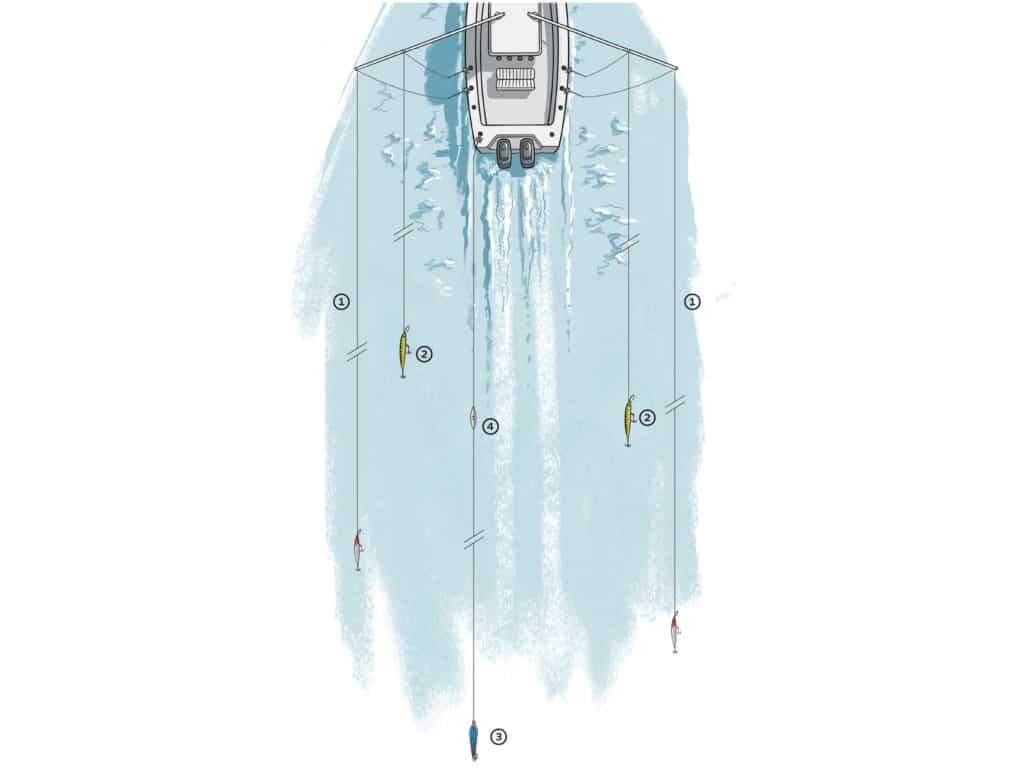 To cover scattered kings, troll high-speed plugs at 6 knots: Run a pair of Rapala CDMag 18s on the long riggers, [1]; a pair of CDMag 25s on the short riggers, [2]; and a Drone 31⁄2 spoon, [3], on the flat line, 75 feet behind a 24-ounce inline sinker, [4].
Steve Sanford
To cover scattered kings, troll high-speed plugs at 6 knots: Run a pair of Rapala CDMag 18s on the long riggers, [1]; a pair of CDMag 25s on the short riggers, [2]; and a Drone 31⁄2 spoon, [3], on the flat line, 75 feet behind a 24-ounce inline sinker, [4].
Steve Sanford
Perry starts the day catching bait with a 7-foot cast net. On a good day, he finds all he needs in front of Rudee Inlet. Other times, he runs along the beach until he spots a school of menhaden. Once he fills the livewell, he doesn’t go far. “We caught our biggest kings in 8 to 30 feet of water,” he says. In fact, he hooked several fish over 60 pounds close to shore. Nevertheless, Perry points out that he catches greater numbers on nearshore wrecks within 15 miles of Rudee Inlet.
Perry’s tactic is simple. He slow-trolls four live baits, two off the long-rigger lines and the other pair off the short riggers at 2 to 3 knots, “Just fast enough to keep them swimming straight.” He usually opts for live menhaden fished on a stinger rig consisting of single-strand No. 5 wire attached to a single 5/0 live-bait hook impaled in the bait’s nose, and a 4X No. 4 treble as a trailer, hooked in the back of the baitfish, right behind the dorsal fin.
When the kings are scattered, Perry resorts to artificial lures, trolling a spread of five at 6 knots—two Rapala CountDown Magnum 18s off the long riggers, two CDMag 25s from the short riggers, and a Drone 3 ½ spoon 75 feet behind a 24-ounce inline sinker. To prevent cutoffs, he attaches 12 inches of No. 5 wire ahead of each plug with a small swivel.
As a die-hard king mackerel angler, I’m always looking to take my skills to the next level. Each fall, I travel to Hatteras, North Carolina, for some of the best kingfishing in the world. Starting in October and running into December, huge schools of big kings descend on the inshore waters off Hatteras Inlet. And after a mild winter and a warm spring, Perry’s hopes are always high for an epic king season.
North Carolina Kingfish Action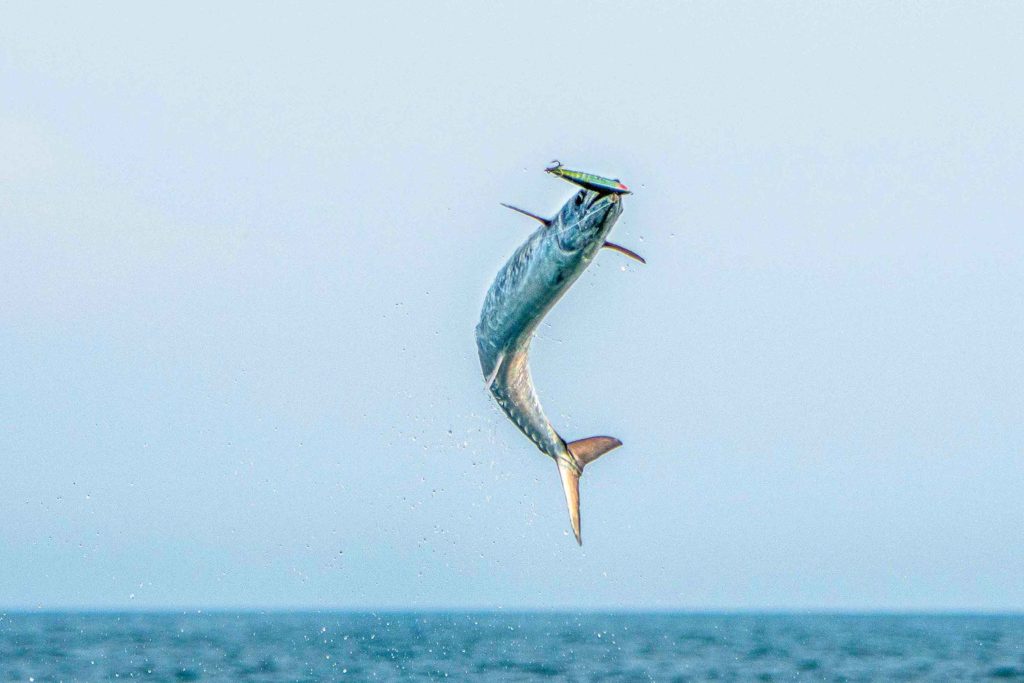 Kings, especially the larger specimens, are famous for skyrocketing during savage attacks on baits and lures.
Jason Stemple
Kings, especially the larger specimens, are famous for skyrocketing during savage attacks on baits and lures.
Jason Stemple
One November, I joined Capt. Rom Whitaker aboard Release for a day in smoker heaven. Like Perry, Whitaker has noticed an improvement in the king mackerel fishing. “But the fish are arriving later,” he admits.
We left Hatteras Inlet and found a school of menhaden. Using a 12-foot cast net with 1-inch mesh, mate Andy Trant quickly loaded the livewell. Whitaker ran about 12 miles, then slowed the boat along a color change, where he marked schools of croakers on the bottom. Trant immediately deployed four live baits from the riggers.
Whitaker says he likes to look for bait on a color change, with a temperature break from 68 to 72 degrees. While they’ll often find kings on local wrecks, and the biggest kings on inshore reefs and rock piles, he claims the best fishing is over the bait marks. Slowly pulling the live baits, we worked both sides of the color change. Whitaker was marking fish, but we weren’t getting bites. So Trant started changing rigs.
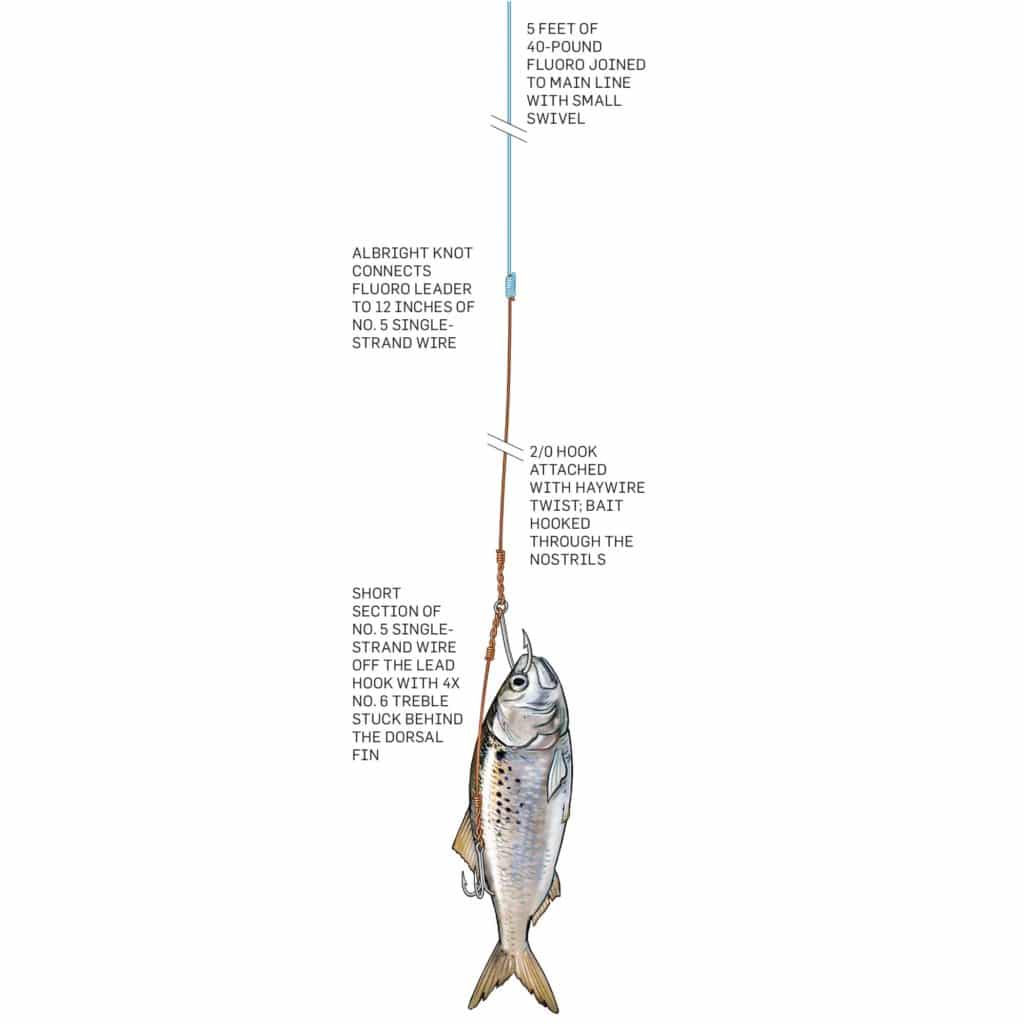 Sharp dentures on king mackerel call for wire to prevent cutoffs. The fish’s equally sharp vision requires keeping wire leaders short and using No. 5 single-strand wire to minimize the potential for detection and rejection.
Steve Sanford
Sharp dentures on king mackerel call for wire to prevent cutoffs. The fish’s equally sharp vision requires keeping wire leaders short and using No. 5 single-strand wire to minimize the potential for detection and rejection.
Steve Sanford
The team starts the day with a sevenstrand cable stinger rig: two 4X No. 4 trebles figure-eight-knotted to the cable, one positioned to hook through the nose of the bait and the other tied to the long tag end as a stinger. “It’s simple, fast and tough,” Whitaker explains. If Whitaker doesn’t get bites on the cable, he goes stealthy.
Starting with a 2/0 single front hook and No. 6 4X trailer on No. 5 single-strand wire, he builds a 12-inch trace with a stinger. He connects that to 5 feet of 40-pound fluorocarbon with an Albright knot, and joins the fluoro to the main line with a small swivel.
“When I see a bait get nervous, I’ll crank the line tight to prevent the king from biting through the line,” Whitaker says.
The change made all the difference. Within minutes of dropping the fourth bait in the water, we had our first bite as a 30-pound king skyrocketed on the long rigger. Once Whitaker had the kings’ ticket, the show was on. We hooked fish up to 40 pounds, and several times we had two or more on at once.
Use Light Drags to Catch King Mackerel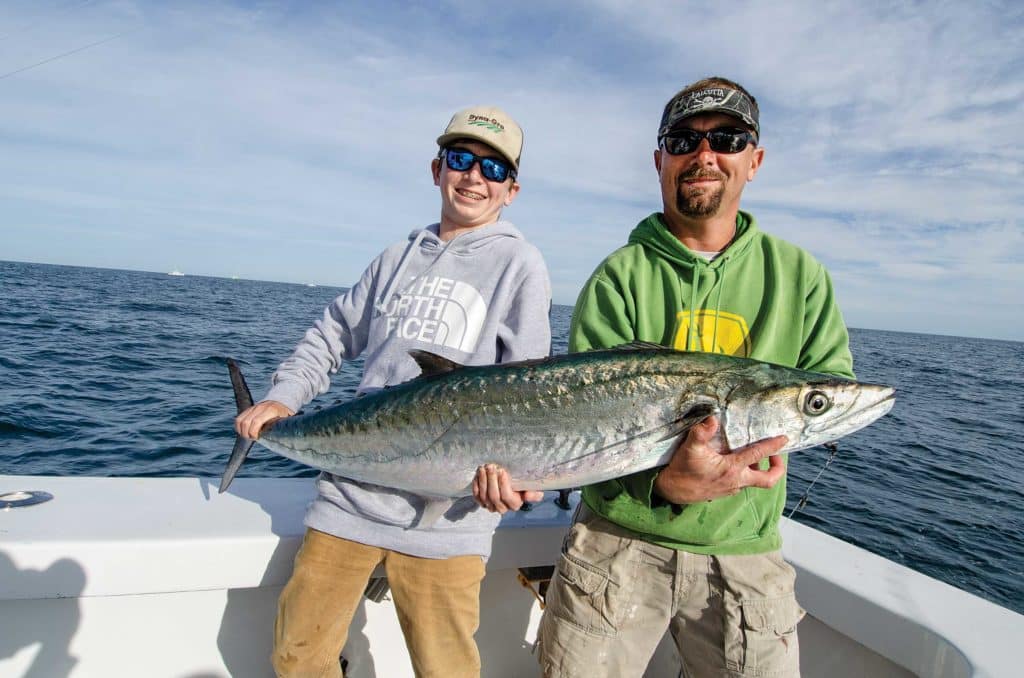 In addition to good reflexes and fishing skills, boating a big king often requires coordination between the angler and crew.
Ric Burnley
In addition to good reflexes and fishing skills, boating a big king often requires coordination between the angler and crew.
Ric Burnley
Big king mackerel follow their brutal, initial attack with a long run, and then settle into a tenuous fight. The key to success, especially with larger fish, is keeping the drag light. Whitaker recommends less than 5 pounds of pressure to avoid pulling the small hooks out of the mackerel’s hard mouth. He’s convinced that patience is a virtue when fighting a king.
After one particular hookup, the rod bent double under the strain from a heavy fish refusing to budge. At the conclusion of a prolonged give-and-take battle with light drag, the angler brought a 25-pound blackfin tuna to the boat. “I’ve caught wahoo, tuna, even blue marlin in the same area,” Whitaker says.
With king mackerel moving farther up the East Coast each year, more anglers have an opportunity to get in on world-class fishing close to shore. Whether slow-trolling live baits or high-speed trolling lures, get ready for aggressive bites, long runs and fast action with big, bad king mackerel.
The post Catch Mid-Atlantic King Mackerel appeared first on Salt Water Sportsman.
- Home
- About Us
- Write For Us / Submit Content
- Advertising And Affiliates
- Feeds And Syndication
- Contact Us
- Login
- Privacy
All Rights Reserved. Copyright , Central Coast Communications, Inc.